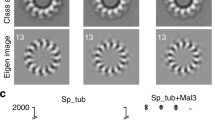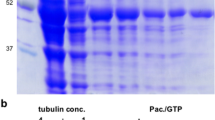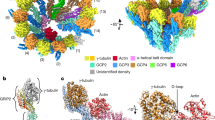Abstract
The heterotrimeric GTP-binding regulatory proteins (G proteins) play an important role in the regulation of membrane signal transduction. Recently, we identified the association of Go protein with mitotic spindles. Here we have investigated the relationship between Go protein and microtubules. We used temperature-dependent reversible assembly and taxol methods to purify microtubules from bovine brains. Goα and Gβ proteins were identified in the microtubular fraction by both methods. The Goα subunit in the microtubular fraction could be ADP ribosylated by pertussis toxin. Co-immunoprecipitation data also revealed that Go protein can interact with microtubules. Exogenous Go protein could be incorporated into the assembled microtubular fraction, and 5 µg/ml (60 nM) of Go protein inhibited 40% of microtubule assembly. Western blot analysis of Goα-1 and Goα-2 in microtubular fractions showed that only Goα-1 is associated with microtubules. We conclude that the Goα-1βγ proteins are associated with microtubules and may play some role in regulating the assembly and disassembly of microtubules.
Similar content being viewed by others
References
Bourne HR, Sanders DA, McCormick F. The GTPase superfamily: A conserved switch for diverse cell function. Nature 348:125–132;1990.
Brandt DR, Ross EM. GTPase activity of the stimulatory GTP-binding regulatory protein of adenylate cyclase, Gs. J Biol Chem 260:266–272;1985.
Brugg B, Matus A. Phosphorylation determines the binding of microtubule-associated protein 2 (MAP2) to microtubules in living cells. J Cell Biol 114:735–743;1991.
Cali JJ, Balcueva EA, Rybalkin I, Robishaw JD. Selective tissue distribution of G protein γ subunits, including a new form of the γ subunits identified by cDNA cloning. J Biol Chem 267:24023–24027;1992.
Correas I, Diaz NJ, Avila J. Microtubule-associated protein tau is phosphorylated by protein kinase C on its tubulin-binding domain. J Biol Chem 267:15721–115728;1992.
Federman AD, Conklin BR, Schrader KA, Reed RR, Bourne HR. Hormonal stimulation of adenylyl cyclase through Gi-protein βγ subunits. Nature 356:159–161;1992.
Florio VA, Sternweis PC. Reconstitution of the resolved muscarnic cholinergic proteins. J Biol Chem 160:3477–3483;1985.
Gelfand VI, Bershadsky AD. Microtubule dynamic: Mechanism, regulation, and function. Annu Rev Cell Biol 7:93–116;1991.
Gilman AC. G proteins: Transducers of receptor-generated signals. Annu Rev Biochem 56:615–649;1987.
Higashijima T, Ferduson KM, Sternweis PC, Smigel MD, Gilman AG. Effects of Mg2+ and the βγ-subunit complex on the interactions of guanine nucleotides with G proteins. J Biol Chem 262:762–766;1987.
Horio T, Hotani H. Visualization of the dynamic instability of individual microtubules by dark-field microscopy. Nature 321:605–607;1986.
Hsu W, Rodulph U, Sanford J, Bertrand P, Olate J, Nelson C, Mors LG, Boyd AE, Codina J, Birnbaumer L. Molecular cloning of a novel splice variant of the α subunit of the mammalian Go protein. J Biol Chem 265:11220–11226;1990.
Jelsema CL, Axelrod J. Stimulation of phospholipase A2 activity in bovine rod outer segments by the subunits of transducin and its inhibition by the alpha subunit. Proc Natl Acad Sci USA 84:3623–3627;1987.
Katz A, Wu D, Simon MI. Subunits βγ of heterotrimeric G protein activate β2 isoform of phospholipase C. Nature 360:686–689;1992.
Kaziro Y, Itoh H, Kazasa T, Hakafuku M, Satoh T. Structure and function of signal-transducing GTP-binding proteins. Annu Rev Biochem 60:349–400;1991.
Kim D, Lewis DL, Graziadei L, Neer EJ, Bar-Sagi D, Clapham DE. G-protein βγ subunits activate the cardiac muscarinic K-channel via phospholipase A2. Nature 337:557–560;1989.
Kopp GS, Woolalis MJ. ADP-ribosylation of G proteins with pertussis toxin. Methods Enzymol 195:257–266;1991.
Li Q, Suprenant KA. Molecular characterization of the 77 kDa echinoderm microtubule-associated protein. J Biol Chem 269:31777–31784;1994.
Lin CT, Wu HC, Cheng HF, Chang JT, Chang KJ. Identification of β subunit of GTP-binding regulatory protein in mitotic spindle. Lab Invest 67:770–778;1992.
Lindwall G, Cole RD. Phosphorylation affects the ability of tau protein to promote microtubule assembly. J Biol Chem 259:5301–5305;1984.
Mattera R, Codina J, Sekura RD, Birnbaumer L. Guanosine 5′-o-(3-thiotriphosphate) reduces ADP-ribosylation of the inhibitory guanine nucleotide-binding regulatory protein of adenylyl cyclase (Ni) by pertussis toxin without causing dissociation of the subunits of Ni. J Biol Chem 262:11247–11251;1987.
Mclaughin SK, Mckinnon PJ, Margolskel RF. Gustducin is a taste-cell-specific G protein closely related to the transducins. Nature 357:563–569;1992.
Mitchison T, Kirschner M. Dynamic instability of microtubule growth. Nature 312:237–242;1984.
Morishita R, Nakayama H, Isobe T, Matsuda T, Hashimoto Y, Okano T, Fukada Y, Mizuno K, Ohno S, Kozawa O, Kato K, Asano T. Primary structure of a γ subunit of G protein, γ12, and its phosphorylation by protein kinase C. J Biol Chem 270:29469–29475;1995.
Neer EJ, Clapham DE. Roles of G protein subunits in transmembrane signaling. Nature 33:129–134;1988.
Neer EJ, Lok JM, Wolf LG. Purification and properties of the inhibitory guanine nucleotide regulatory unit of brain adenylate cyclase. J Biol Chem 259:14222–14229;1984.
Neer EJ. Heterotrimeric G protein: Organizers of transmembrane signals. Cell 80:249–257;1995.
Northup JK, Smigel H, Sternweis PC, Gilman AG. The subunits of the stimulatory regulatory component of adenylate cyclase. J Biol Chem 258:11369–11376;1983.
Olmsted JB. Microtubule-associated proteins. Annu Rev Cell Biol 2:421–457;1986.
Ong OC, Yamane HK, Phan KB, Fong HK, Bok D, Rehwa H, Lee RH, Fung BK. Molecular cloning and characterization of the G protein γ subunit of cone photoreceptors. J Biol Chem 270:8495–8500;1995.
Peraldi S, Nguyen B, Brabet P, Homburger V, Rouot B, Toutant M, Bouille C, Assenmacher I, Bockaert J, Gabrion J. Apical localization of the alpha subunit of GTP-binding protein Go in choroidal and ciliated ependymocytes. J Neurosci 9:806–814;1989.
Popova JS, Garrison JC, Rhee SG, Rasenick MM. Tubulin, Gq and phosphatidylinositol 4,5-bisphosphate interact to regulate phospholipase Cβ1 signaling. J Biol Chem 272:6760–6765;1997.
Ray K, Kunsch C, Bonner LM, Robishaw JD. Isolation of cDNA clones encoding eight different human G protein γ subunits, including three novel forms designated the γ4, γ10, and γ11 subunits. J Biol Chem 270:21765–21771;1995.
Roychowdhury S, Panda D, Wilson L, Rasenick M. G protein α subunits activate tubulin GTPase and modulate microtubule polymerization dynamics. J Biol Chem 274:13485–13490;1999.
Roychowdhury S, Rasenick MM. G protein β1γ2 subunits promote microtubule assembly. J Biol Chem 272:31576–31581;1997.
Ryba NJ, Tirindelli RA. Novel GTP-binding protein γ-subunit, Gγ8, is expressed during neurogenesis in the olfactory and vomeronasal neuroepithelia. J Biol Chem 270:6757–6767;1995.
Simon MI, Strathmann MP, Gautam N. Diversity of G protein in signal transduction. Science 252:802–808;1991.
Sternweis PC, Northup JK, Smioge MD, Gilman AG. The regulatory component of adenylate cyclase, purification and properties. J Biol Chem 256:11517–11526;1981.
Sternweis PC, Robishaw JD. Isolation of two proteins with high affinity for guanine nucleotides from membranes of bovine brain. J Biol Chem 259:13806–13813;1984.
Strathmann M, Wilkie TM, Simon MI. Alternative splicing produces transcripts encoding two dorms of α subunit of GTP binding protein Go. Proc Natl Acad Sci USA 87:6477–6481;1990.
Stryer L, Bourne HR. G proteins: A family of signal transducers. Annu Rev Cell Biol 2:391–419;1986.
Tang WT, Gilman AG. Type-specific regulation of adenylyl cyclase by G protein βγ subunits. Science 254:1500–1503;1991.
Tsukamoto T, Toyama R, Itoh H, Kozasa T, Matsuoka M, Kaziro Y. Structure of human gene and two rat cDNAs encoding the alpha chain of GTP-binding regulatory protein Go: Two different mRNAs are generated by alternative splicing. Proc Natl Acad Sci USA 88:2974–2978;1991.
Vallee RB, Borisy GG. The non-tubulin component of microtubule protein oligomers. J Biol Chem 253:2834–2845;1978.
Vallee RB. A taxol-dependent procedure for the isolation of microtubules and microtubule-associated proteins (MAPs). J Cell Biol 92:435–442;1982.
Vallee RB. Purification of brain microtubules and microtubule-associated protein I using taxol. Methods Enzymol 134:104–115;1986.
Vallee RB. Reversible assembly purification of microtubule without assembly-promoting agents and further purification of tubulin, microtubule-associated proteins, and MAP fragments. Methods Enzymol 134:89–104;1986.
Walker RA, O'Brien ET, Pryer NK, Soboerio MF, Voter WA, Erickson HP, Salmon ED. Dynamic instability of individual, MAP-free microtubules analyzed by video light microscopy: Rate constants and transition frequencies. J Cell Biol 107:1437–1448;1988.
Wang N, Rasenick MM. Tubulin-G protein interactions involve microtubule polymerization domains. Biochemistry 30:10957–10965;1991.
Wang N, Yan K, Rasenick MM. Tubulin binds specifically to the signal-transducing protein, Gs alpha and Gi alpha 1. J Biol Chem 265:1239–1242;1990.
Wu HC, Huang PH, Lin CT. G protein beta subunit is closely associated with microtubules. J Cell Biochem 70:553–562;1998.
Wu HC, Lin CT. Association of heterotrimeric GTP binding regulatory protein (Go) with mitosis. Lab Invest 71:175–181;1994.
Author information
Authors and Affiliations
Rights and permissions
About this article
Cite this article
Wu, HC., Chiu, CY., Huang, PH. et al. The association of heterotrimeric GTP-binding protein (Go) with microtubules. J Biomed Sci 8, 349–358 (2001). https://doi.org/10.1007/BF02258377
Received:
Accepted:
Issue Date:
DOI: https://doi.org/10.1007/BF02258377




